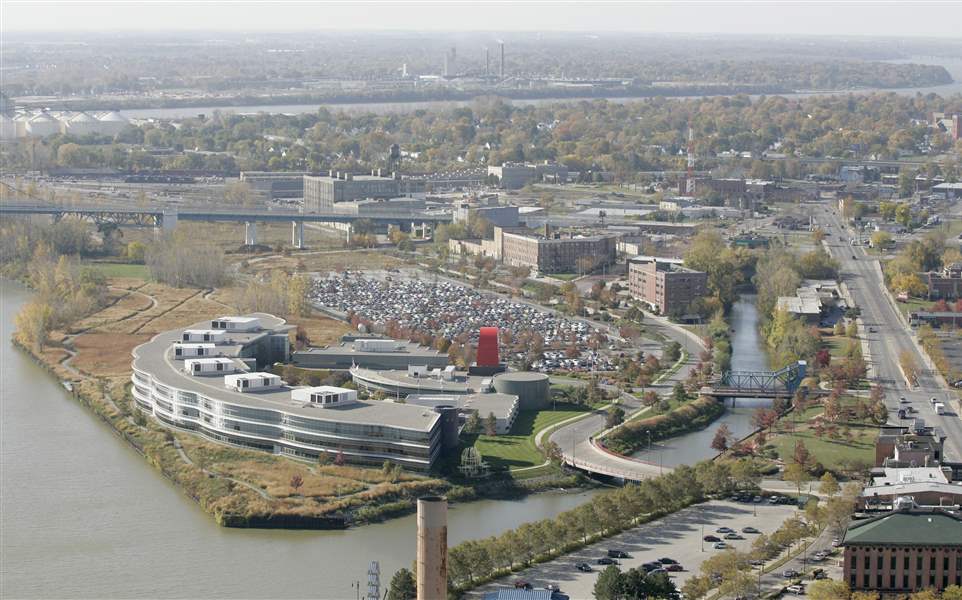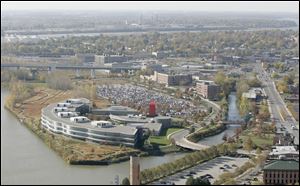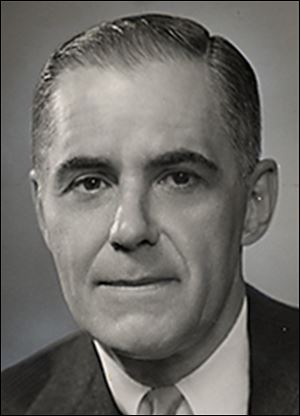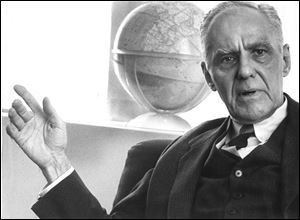
OWENS CORNING: A TOLEDO MAINSTAY FOR 75 YEARS
A marriage of two companies, Owens Corning celebrates 75th anniversary
Its HQ still in Toledo, its products in your home
10/27/2013
Owens Corning's current lease on its headquarters building along the Maumee River expires in 2015, but officials said earlier this month that the company and the Bell administration have a tentative agreement on an incentive package to keep the company there until at least 2030.
THE BLADE
Buy This Image

Owens Corning's current lease on its headquarters building along the Maumee River expires in 2015, but officials said earlier this month that the company and the Bell administration have a tentative agreement on an incentive package to keep the company there until at least 2030.
In the mid-1930s, two giants of the glass industry were experimenting with a new product.
Owens-Illinois Inc. and Corning Glass Works both saw potential in their development of glass textiles, but the market was small at the time and neither company was profiting from the work.
Instead of pressing ahead separately, the firms decided to collaborate, sharing equipment, personnel, and lab space.
What became Owens Corning was led by Harold Boeschenstein, a World War I second lieutenant from Edwardsville, Ill., who recognized the growing global nature of business. During his 29 years at the helm, annual sales grew from $4 million to hundreds of millions and by 1957 he was included in Forbes magazine’s list of 50 foremost business leaders.
PHOTO GALLERY: Click here to see OC photos from the past 75 years
He had been a glass company executive in Toledo since 1929. He was named vice president and general manager of Owens-Illinois Glass Co. when it was formed by the merger of Illinois Glass Co. and Owens Bottle Co. He moved up through various positions at Owens-Illinois and in 1938 became the first president of Owens-Corning Fiberglas Corp.

Boeschenstein
In a 1960 speech, he said, “Tremendous changes are taking place. History seems to be moving toward a climax. The time when we could attend to our local affairs without reference to international affairs is long past. Two world wars and the tremendous developments in transportation and communications have erased barriers and contracted the size of our world.”
Among the executives he fostered was his own son, William W., who was chief executive of Owens Corning for 17 years before retiring in 1990.
Harold Boeschenstein died in 1972 at 76. After his death, a Blade editorial called him “a dynamic, driving, intensely competitive man who shared his abundance of talent unselfishly with his adopted hometown, Toledo.” And it noted: “The uses of fiber glass have exploded from a half-dozen or so in 1938 to more than 33,000. He was justly known as ‘Mr. Fiberglas.’ ”
The experimental work undertaken went well, but it was still a tiny part of two very big companies. Fearing the progress and investment might get lost without a dedicated management team and board, Owens-Illinois and Corning decided to spin off the operations and create a company called Owens-Corning Fiberglas Corp.
As the company — now called Owens Corning — celebrates its 75th anniversary this week, it is every bit as much a global powerhouse, as its parent companies and fiber-glass composites are found in products ranging from automobiles to giant wind turbines.
Arnaud Genis, president of OC’s composites segment, said there are as many as 70,000 applications for glass-fiber composites.
“You will find our products in appliances, in your kitchen, in your home, in electronics like phones, computers, tennis rackets, golf equipment, boats.”
In other words, Owens Corning is everywhere.
Fortune 500 firm
The only Fortune 500 company still headquartered in Toledo, OC employs more than 15,000 people in 27 countries on five continents. It reported total sales of $5.2 billion last year.
Owens Corning is the market leader in residential insulation and a major producer of roofing materials. It also has a significant composites business. In many ways, it has led the industry.
“We’re proud of our heritage of pioneering and creating some of the applications that are now widespread for composites,” said John Hillenbrand, the company’s chief innovation officer.
OC weathers stormy times over long haul
Longtime Owens Corning leader William Boeschenstein
Pink Panther, color carry considerable value
Owens Corning composite materials found in countless products
All from those humble beginnings in 1938.
Bill Hamilton, a retired public relations executive with OC who now moonlights as company historian, recalled a story from the early days about a salesman who spent six weeks on the road to sell just 36 fiber-glass furnace filters.
But better days were ahead.
“I think the first big commercial success for the company was a product called navy board,” Mr. Hamilton said.
War years and beyond
The U.S. Navy needed a new insulation that wouldn’t slump when installed vertically in ships. Owens Corning developed just such a product that was fireproof to boot. In 1939, the U.S. Navy Bureau of Ships decided the product should be installed in all new warships.
“That was greatly successful and carried the company for the first seven years of its existence,” Mr. Hamilton said.
The war effort found other uses for OC’s products. There were fireproof parachutes for flares, reinforced plastic parts for warplanes, life jackets, and more. It helped to familiarize the public with fiber glass.
“Typically it’s very hard to introduce a new material because engineers and designers are used to working with materials they’ve used for years. To switch to a new material is risky,” Mr. Hamilton said.
War made materials scarce, helping to open the market and prove the worthiness of fiber glass.
The next decade brought the creation of the company’s trademark pink fiber-glass insulation and development of early roofing products. The company was also a pioneer in fiber-glass boats and composite car bodies and was the first to the develop fiber-glass mat-based shingles that soon spread through the industry.
Founded: Oct. 31, 1938
World headquarters: 1 Owens Corning Pkwy., Toledo
Global employees: 15,169
Ohio employees: 2,149
Employees based at world headquarters: 949 plus 300 contractors
Fortune 500: No. 472 on 2013 list.
2012 revenue: $5.2 billion
Products: Building materials and various composites, with some major products including Duration shingles, EcoTouch insulation, Thermafiber insulation
The company is celebrating its 75th anniversary by ringing the closing bell at the New York Stock Exchange on Monday.
“We are the most innovative,” Mr. Genis said. “We are always copied. Whenever we launch a solution, we know we will be in a sweet spot for 18 months or 24 months before someone has copied us and launched a ‘me too’ solution.”
Though that can be frustrating, company officials also look at their followers as a testament to the role the firm has played.
Downtown presence
Owens Corning has been based in downtown Toledo since its founding. Its headquarters were established in 1938 in what was at the time the Second National Bank building downtown. The building is now the Riverfront Apartments.
Owens Corning moved in 1969 into the new Fiberglas Tower, a building that it called home until 1996, when it moved into a new, three-story building on the bank of the Maumee River.
The company’s lease on that building expires in 2015, but officials said earlier this month that the company and the Bell administration have a tentative agreement on an incentive package to keep the company there until at least 2030.
Owens Corning considered leaving downtown once before. In 1993, OC announced it would vacate its downtown tower, possibly for another spot in Toledo, possibly for Monclova Township, possibly for Granville, Ohio, where its Science and Technology Center is.
In early 1994, OC said it would build a new headquarters along the river — if all the land could be acquired and the soil passed environmental tests.
Former Mayor Carty Finkbeiner, who came into office in 1994 and was involved in the negotiations to keep OC downtown, said it was important to do all that was possible to prevent the company from leaving the city.
“I think with O-I’s move to Perrysburg, and a much less visible presence in community problem-solving efforts, Owens Corning’s presence in downtown Toledo and its leaders’ presence in all kinds of different ways has been ... important and valuable to our city,” Mr. Finkbeiner said recently.

Upon his death, Harold Boeschenstein, shown in 1971 was described in a Blade editorial as 'a dynamic, driving, intensely competitive man who shared his abundance of talent unselfishly with his adopted hometown, Toledo.'
Impact on Toledo
The value of having OC based downtown is difficult to quantify.
The company has 949 employees at the world headquarters, as well as 300 contractors who work out of the building. Total payroll at the site is about $200 million. The company says Toledo gets $3 million annually in payroll taxes.
Toledo officials declined to say how much OC itself pays, citing IRS rules.
“Having a large corporate presence that has good salaries is always a good thing,” said Ned Hill, dean of the Maxine Goodman Levin College of Urban Affairs at Cleveland State University.
Mr. Hill said big companies help create a vibrancy and beyond that, it’s beneficial for a city to have global businesses that give them name recognition.
“If you go anywhere in the United States and you mention Toledo, you’re going to hear Owens. The fact is Jeep and Owens are well-connected to the city, which is helpful not just to the city but to the whole region,” he said.
For Mr. Finkbeiner, the company’s tie to Toledo was even personal. A number of his high school classmates went on to become executives with OC.
Ups and downs
Owens Corning has had its difficulties — the company fought off a damaging hostile takeover attempt in 1986, faced such liabilities from asbestos-related lawsuits that it chose to file for bankruptcy in 2000 and remained there until 2006, and then had to weather a massive downturn in residential home construction starting in about 2007.
Through it all, Owens Corning has survived. It has been on the Fortune 500 list of biggest companies, ranked by revenue, every year since the list began in 1955.
Today, the company says it’s well positioned for the future.
Owens Corning did not make Chief Executive Officer Mike Thaman available for comment for this article. However, on an earnings conference call last week, Mr. Thaman was upbeat about the work the company has done to position itself, as well as the future of the U.S. residential housing market.
Chuck Dana, president of Owens Corning’s building materials group, said the company is also benefiting from a greater emphasis on energy efficiency and building codes that are more stringent.
“The concept of insulation is easier to talk about today than it was in 1960,” he said. “It might have been viewed as an incremental cost at that point in time, where today it’s clearly an investment.”
The company’s insulation business slumped as U.S. housing starts fell, but OC said last week the segment is on track to return to profitability this year.
In the consumer space, the company may be best-known for its marketing of insulation with the Pink Panther.
But Mr. Dana said the company has a much deeper relationship with its customers.
“The brand is a lot more than just a pink color and a panther,” he said. “I think that we’re listened to. We can always get an appointment with builders. We can always get an appointment with code regulators. They know we know what we’re talking about. They believe in the integrity of the company.”
Contact Tyrel Linkhorn at tlinkhorn@theblade.com or 419-724-6134.